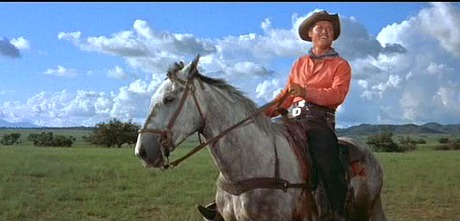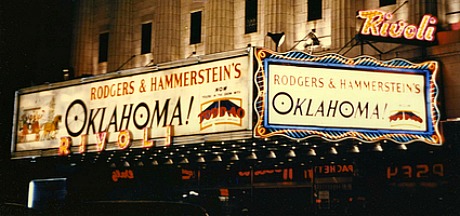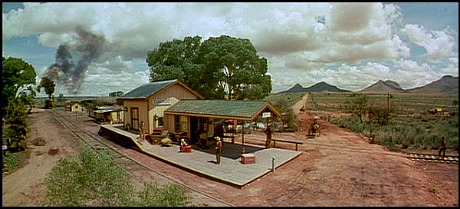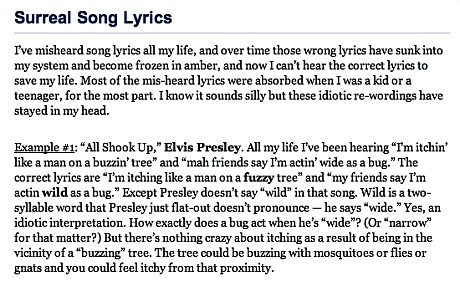A little suspicion is in order when the Houston-residing Joe Leydon reviews a film set in Texas and/or written by a Texan. You just can’t trust that local-pride factor. Better to consult Hollywood Reporter critic John DeFore, to wit: “Robert Duvall and Bill Witliff return to the Southwest in Emilio Aragon‘s A Night in Old Mexico, where the Lonesome Dove screenwriter and its irascible star follow an aging rancher on an ill-advised trip South of the Border. Formulaic and often hard to swallow, the picture offers little beyond the familiar pleasures of Duvall’s old-coot mode; it has moderate theatrical appeal, but will stand as a blip in its star’s filmography compared to Dove and his other cowpoke outings.” Never forget the immaculate restraint in Duvall’s Tender Mercies performance — one for the ages.
Day: March 28, 2014
Vivian and Cleopatra

No particular reason to post this summer 1963 snap except that I’m queer for old color Times Square marquee photos. I had never seen a shot of the Cleopatra marquee until today. The Todd-AO process that was used to shoot Cleopatra was a degraded, 24-frame version of the 30-frame process used to shoot Oklahoma!

Stanley Kubrick hugging daughter Vivian during filming of The Shining in 1979. Until today I’d never seen a photo of Kubrick being physically affectionate with anyone. Vivian, 18 or 19 at the time of the photo, joined the Church of Scientology sometime around 1999, the year her father died. A resident of Los Angeles, Vivian has been, according to Kubrick’s widow Christiane, largely estranged from the family and uncommunicative for several years. She allegedly attended LACMA’s Stanley Kubrick exhibit more than once and, according to a friend, with some regularity on Tuesdays. (Photo source: theoverlookhotel.com)
Semple Is Gone
Screenwriter Lorenzo Semple, Jr., a classy, first-rate screenwriter who peaked in the late ’60s and ’70s but is probably best known to 21st Century types for his “Real Geezers” video critiques with Marcia Nasatir, died earlier today. His best screenplays were Pretty Poison (’68), The Marriage of a Young Stockbroker (’71), Papillon (co-penned with Dalton Trumbo, ’73), The Parallax View (co-written by David Giler, ’74), The Drowning Pool (’75) and Three Days of the Condor (with additional flavorings and grace notes by David Rayfiel, ’75). Semple was a sharp, shrewd, blunt-spoken professional — my kind of old guy.
Better-Than-Ever Oklahoma!, You Bet
I’ve never been a huge fan of Fred Zinneman‘s Oklahoma! (’55) but I love the 30-frame Todd AO process in which it was originally filmed (along with a concurrent, nearly identical version that was shot in 35mm Scope). An extra six frames per second means exceptional clarity and eye-popping realism, especially when the Todd-AO cameras are moving as the 30-frame process eliminates almost all traces of motion blur. And now it can be savored anew with Fox restoration guru Schawn Belston having restored the 30-frame Oklahoma! to a state that looks even cleaner and more robust than it did on the big curved screen at Manhattan’s Rivoli when it opened on 10.11.55.



Art of Caution, Delay, Hesitation
In the 32 years since Warren Beatty won the Best Director Oscar for Reds, he’s directed three films and acted in four — one film every 4.5 years. And if he could have written his life story with any candor or zeal he could have delivered one of the greatest Balzac-ian novels of the 20th Century because he knows (or knew) everyone and has been through and absorbed it all and has a million epic stories under his belt. But that’s water under the bridge. The visually dazzling Dick Tracy (’90) and the politically radical Bulworth (’98) are as audacious and well-crafted as Reds in their own way, and now he’s shooting his long-gestating Howard Hughes flick. Plus he’s acted in a notorious wipeout that eventually became a cult comedy (Ishtar), a riveting, highly intelligent gangster flick (Bugsy), a dud remake that also lost money (Love Affair) and a financially calamitous marital infidelity comedy (Town and Country) that was a lot better than most people remember and has at least one classic scene (i.e., when he’s confronted by Diane Keaton and Goldie Hawn about having cheated and he goes through a whole irate “how dare you even ask such a thing?” rant.). Obviously too little activity, but Beatty has never aimed low (or even at the middle) or taken a straight paycheck gig. He even managed to perplexingly turn down the David Carradine role in Kill Bill.
Bruckheimer’s Golden Years
Over the last 40-plus years Jerry Bruckheimer‘s producing career has gone through four phases. Phase #1 was his solo run from ’72 through ’84 (Thief, Cat People). JB’s successful partnership with Don Simpson (Flashdance to Dangerous Minds), lasting 11 or 12 years, was Phase 2. The five-year-long Phase 3 (from Simpson’s death in January ’96 until Pearl Harbor) was Bruckheimer’s solid-gold period, a time when “produced by Jerry Bruckheimer” meant elite, sharply-written, sirloin-steak guy movies like The Rock, Con Air, Enemy of the State, Armageddon, Remember the Titans, Gone in Sixty Seconds and Black Hawk Down.
It gives me no pleasure to note that Phase 4 (’01 to ’14) has mostly been a “fuck it, go for the corporate family-entertainment money” period. Bruckheimer could man up and return to Phase 3, but it’ll never happen. Jerry knows it, I know it, we all know it. Alan Moore‘s famous remark about how “in our lifetime, we will see Johnny Depp playing Captain Crunch” was obviously a direct comment about the attitude that Bruckheimer adopted in the 21st Century.
The Singer, Not The Song
Two and half years ago I posted a riff about misunderstood (or deceptively mis-pronounced) pop lyrics. Example: Whenever I listen to Smokey Robson and the Miracles‘ “(The Love I Saw in You Was) Just A Mirage,” instead of the phrase “now all that’s left are lipstick traces” I hear “now all that’s left, I miss Dick Tracy.”

I was standing in a checkout line at Staples last week, and the p.a. system was playing Manfred Mann‘s “Doo-wah-diddy-diddy-dum-diddy-doo.” I know that the chorus goes “now I’m hers, she’s mine…I’m hers, she’s mine, wedding bells are gonna chime.” But all my life I’ve heard the following: “Now I’m hurt, she’s mad…I’m hurt, she’s mad, wedding bells are gonna chime.” Yes, obviously, I know…why would there be wedding bells if he’s hurt and she’s mad? I’ve been hearing it this way regardless. It’s the singer’s fault. He can’t say the word “hers” and sound rock-and-roll guttural so he pronounced it as “hurt.” And it sounds dorky to sing “miiyeen” so he decided to pronounce it as “mahhnn” and it came it like “mad.” So don’t blame me.
Can The Wrong Actor Ruin Your Movie?
Whenever filmgoers are presented with a romantic couple consisting of a famous actress and a less-well-known boyfriend, they immediately become protective of the actress by assessing and deciding if the boyfriend is (a) a good guy and worth staying with or (b) an egoistic, untrustworthy, not-hot-enough dick who needs to be jettisoned at the first opportunity. 60 seconds after being introduced to Adam Levine in John Carney‘s Begin Again (formerly Can A Song Save Your Life?), in which he plays Keira Knightley‘s famous musician boyfriend, I knew he was toast. I just knew. Not good-looking enough, for one thing. I also hated Levine’s dress sense and his fake serenity and slightly detectable air of entitlement. (He’s the lead vocalist for Maroon 5 and a rich entrepeneur who’s marketed his own fragrance and menswear collection.) I also felt a tiny bit alienated from Knightley for being with Levine in the first place. How come I could see through this asshole right away and she couldn’t? I began to feel repelled by images of Knightley (or anyone for that matter) having sex with Levine. I honestly wanted to see him get hit by a bus or die in a plane crash, or at the very least get beaten up in a fight. Levine is rat poison.

Will you look at those beady little pig eyes and stubbly face and oddly shaped nose? I’m sorry but Adam Levine’s performance in Begin Again ignited extraordinary negativity and repulsion.
“Old Testament on Acid”
If you’re a true Christian (or a true mystic or spiritualist) you have some idea of how inspiration works. It’s never announced or spelled out, for one thing. It comes in soft little pings or a very faint tapping on the door. Or sometimes as a visual metaphor. An image you might understand the instant it appears…or not. This is how God talks to Russell Crowe in Noah, and it’s one of the trippiest little moments I’ve ever experienced in a mainstream film. This is (or at least should be) the value of Noah for those Christians who aren’t ignorant, climate-change-denying, Republican-supporting assholes. It’s genuinely mystical at times, and when it’s not that it’s at least imaginative or audacious or somewhat nutty. Most movies go in the other direction — they try to numb you out with tropes you’ve seen a million times. But Darren Aronofsky was not asleep at the wheel when he cowrote and directed this puppy. If you don’t appreciate Noah‘s general verve and occasional nuttiness then I don’t know what to say to you. Go rent Pompeii or something.
